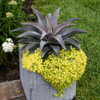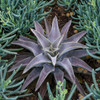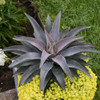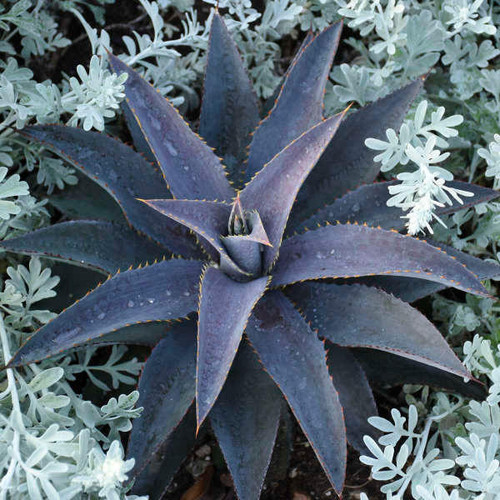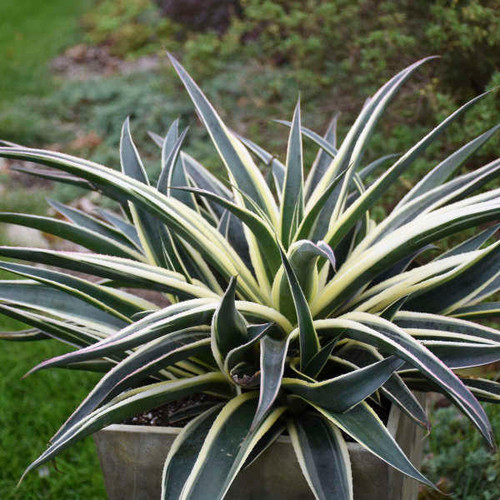Product Description
Mangave 'Purple People Eater' PP29949 - MAD ABOUT MANGAVE Collection (72)ct Flat
Common Name: Mangave
This succulent is named after the famous novelty song, but it's not about to eat anybody! Rather, the extremely purple coloration is where it gets its name from. A neat rosette of thick, sturdy leaves that are blue-green with reddish-purple spotting. However, while walking by, the color will look purple. Bring out its best coloration in full sun; less intense exposure will produce greener leaves. Margins fold upward to show off its yellow, orange, and cinnamon brown spines. At the end of each leaf, there is a cinnamon terminal spine.
Mangave is a relatively new phenomenon, an intergeneric cross of Manfreda x Agave. These rare hybrids combine the best of both worlds: the better growth rate and the interesting patterns of Manfreda, and the habit and refinement of Agave. We are very excited (shall we say mad?) about our new hybrids from Walters Gardens hybridizing.
Mangave is a tender perennial or "temperennial" succulent plant that grows best in full sun. Plant in well-drained, dry to average soil in containers just slightly wider than the width of the rosette or plant directly in the ground. In summer when the plants are actively growing, they appreciate a bit of supplemental watering and half-strength fertilizer. They should be grown dry in winter. Mangave is a slower grower, so it will not quickly overtake the space it is allotted in the landscape.
Height: 12.0-16.0 Inches
Spread: 16.0-24.0 Inches
Hardiness Zones: 9,10,11
Foliage Color: Purple shades
Full Sun (> 6 hrs. Direct Sun)
Low Water Needs
Poor to Average Soil Quality
Deer and Rabbit Resistant
Growth Rate: Slow
Container, Drought Tolerant, Attractive Foliage, Small, Specimen, Focal Point, Native to North America
Gardeners seeking a unique and low-maintenance succulent will be captivated by the Mangave 'Purple People Eater,' a hybrid that inherits the best traits of both Agave and Manfreda . This captivating plant is known for its striking foliage, displaying a deep purple coloration with dark spots that intensify when exposed to sunlight . The leaves are thick and sturdy, forming a symmetrical rosette that adds a touch of drama to any garden or container . Interestingly, this succulent's name is inspired by the 1958 novelty song "Purple People Eater" by Sheb Wooley.
Origins and Characteristics
Mangave 'Purple People Eater' is a cultivated hybrid, meaning it does not occur naturally in the wild. Its parent plants, Agave and Manfreda, are native to the arid and semi-arid regions of North and Central America, particularly Mexico and the southwestern United States . This captivating succulent belongs to the asparagus family (Asparagaceae), which also includes agaves and hostas . It is a hybrid created by Hans Hansen at Walters Gardens in Zeeland, Michigan, resulting from a cross between Mangave 'Bloodspot' and Agave pablocarrilloi (also known as Agave gypsophila).
This perennial succulent grows in a compact, rosette-forming habit, reaching a height of 12 to 16 inches and spreading about 16 to 24 inches wide . Its compact size makes it an excellent choice for various garden settings, including container gardening, rock gardens, and borders . When grown outdoors in full sun, this cultivar can reach 24 inches wide and 16 inches tall at maturity.
The most distinctive feature of the Mangave 'Purple People Eater' is its foliage. The thick, sturdy leaves are blue-green with reddish-purple spots that appear purple from a distance . The margins of the leaves fold upward, revealing yellow, orange, and cinnamon brown spines, with a darker terminal spine at the end of each leaf . Mangave is a relatively new phenomenon, an intergeneric cross of Manfreda and Agave. These rare hybrids combine the best of both worlds: the better growth rate and the interesting patterns of Manfreda, and the habit and refinement of Agave . They are also less spiny than typical Agaves, making them safer to manage.
Growing and Caring for Your Mangave 'Purple People Eater'
Mangave 'Purple People Eater' is a relatively low-maintenance plant, making it a popular choice for gardeners of all skill levels. Here are some essential tips for growing and caring for this captivating succulent:
Light Requirements
This succulent thrives in full sun and needs at least 6 hours of direct sunlight daily for optimal growth and color development . While it can tolerate some shade, less intense exposure will result in greener leaves with less vibrant purple coloration.
Soil and Water
Mangave 'Purple People Eater' prefers well-drained soil and is highly drought-tolerant . It stores water in its thick leaves, allowing it to survive prolonged periods without rainfall . Once established, it requires minimal supplemental watering, especially during the hot season . When watering, ensure the soil dries out completely between waterings to prevent root rot. Mangave 'Purple People Eater' is a slower grower, so it will not quickly overtake the space it is allotted in the landscape . It can tolerate a bit more shade and water than regular Agave, especially when they are establishing roots.
Hardiness and Temperature
This succulent is hardy in USDA zones 9 to 11 and thrives in temperatures between 60-75°F (15-24°C) . It prefers warm climates and should be protected from frost.
Planting Time
In hot climates, it is best to plant Mangave 'Purple People Eater' in the fall when temperatures are lower, allowing it to acclimate slowly to the intense summertime conditions.
Fertilization
While Mangave 'Purple People Eater' generally does not require frequent fertilization, you can use a half-strength fertilizer during the summer months to encourage growth . Avoid over-fertilizing, as this can lead to excessive growth and weaken the plant.
Pests and Diseases Mangave 'Purple People Eater' is generally pest and disease-resistant. However, it is essential to watch for common succulent pests such as mealybugs, scale, and thrips. Treat any infestations promptly to prevent damage to the plant.
Uses and Benefits in the Garden Mangave 'Purple People Eater' is primarily used as an ornamental plant due to its unique and attractive appearance . Its low-maintenance requirements and drought tolerance make it an excellent choice for xeriscaping and water-wise gardens . It is also resistant to deer and rabbits, reducing the likelihood of damage from these animals.
This versatile succulent can be planted in various garden settings:
- Rock gardens The plant's unique texture and color contrast beautifully with rocks and gravel, creating a dramatic and low-maintenance landscape.
- Succulent gardens It adds a striking focal point to succulent gardens with their dramatic foliage and contrasting colors.
- Borders Its compact size makes it ideal for edging walkways or garden beds, adding a touch of sophistication.
- Containers It thrives in containers, allowing for versatile placement in patios, balconies, and indoor spaces, bringing a touch of the outdoors inside.
If you are looking for a unique and low-maintenance succulent to add to your collection, the Mangave 'Purple People Eater' is an excellent choice. Its striking foliage and adaptability make it a versatile and rewarding addition to any garden. Consider pairing it with companion plants like Agastache 'Royal Raspberry', Dianthus 'Double Bubble', Festuca 'Elijah Blue', Lagerstroemia 'Lava Java', or Nepeta 'Purrsian Blue' to create a truly stunning display . With its captivating presence and easy care, the Mangave 'Purple People Eater' is sure to become a favorite among gardening enthusiasts.
Other Details
The most important part of the plant is its root system. Healthy roots are the foundation of a healthy, vibrant plant. The type of plug container used is based on the specific needs of the plants. Perennials offered as bare root traditionally perform better when planted as bare root.Planted in a specialized mix, potted plants have well established root systems. Top growth stage will vary depending on the current life cycle and time of year when shipped. In Winter and early Spring dormant plants may be shipped. Dormant plants may be planted right away, even before the last frost date.
Most bare root varieties are field grown for at least one season, though Hemerocallis and Hosta are grown for two seasons. The bulk of the soil is removed during the harvesting process and the tops of most varieties are trimmed back to the crown. They are graded, packed in shredded aspen or sphagnum moss and stored in freezers until ready to be shipped.
See our Container Sizes and Bare Root Perennials pages for more information.
Plant information and care is provided in the Overview section, Plant Genus Page and general information is provided in the Planting Care & Guides. Additional questions can be asked on each Plant page.
Plant Spacing: Using the maximum mature spread or width of a plant to guide spacing, ensures space to grow to full size. To fill an area sooner, plant them closer together. Just remember, future thinning or transplanting may be needed.
Water: Keep a close eye on newly planted perennials, especially throughout the first growing year. Most early plant loss is due to too much or too little water!







